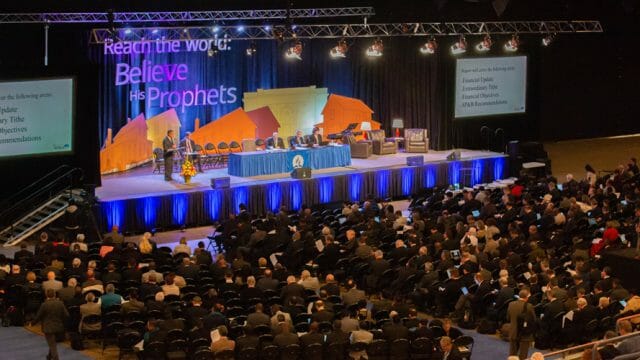What our Nativity scenes don’t often show

Some years ago our church decided to decorate the sanctuary with Nativity scenes from different countries and ethnic groups. Scenes from Asia, Africa, and Europe filled the church. Some were carved in stone, others in wood. In one, Mary wore a sari. In another, the Wise Men came on llamas rather than camels. In another Nativity, obviously originating in a cold climate, everyone was bundled in fur coats. Tropical palm branches formed the stable walls and roof in another Nativity.
Despite the fact that Baby Jesus, Mary, and Joseph looked very different, there was something shared by all scenes: the Nativity scenes looked beautiful, the expressions serene, and the setting—be it a cave, an elaborately carved room looking more like a palace than a barn, or a tropical shelter—looked clean, comfortable, and safe.
* * *
“Now the birth of Jesus Christ was as follows: After His mother Mary was betrothed to Joseph, before they came together, she was found with child of the Holy Spirit. Then Joseph her husband, being a just man, and not wanting to make her a public example, was minded to put her away secretly.” (Matt. 1:18, 19).*
The original story of the birth of Jesus, the Messiah, reads very differently in the gospels. It is a rather gritty and tense story filled with insecurity, fear, pain, and dirt. It is a story of a young woman who has to come to terms with a truly “unbelievable” message from God. Who would believe her? Would Joseph stand by her side? What would this turn of events mean for Joseph and Mary facing all the gossip of Nazareth?
This is the story of a teenage mother in labor pains who cannot find a decent place to give birth to her firstborn Son and needs to make do with a dirty, dusty, dark, and stinking cave or stable. No heart monitor or any other modern health-care gadget, not even clean covers—never mind sterile! It is a story of outsiders who are forced onto the fringe of Bethlehem’s society. While both Mary and Joseph, being descendants of David, may have had some distant relatives in David’s city, they still were from Galilee—over there—and poor on top of it.
* * *
“And it came to pass in those days that a decree went out from Caesar Augustus that all the world should be registered. . . . So all went to be registered, everyone to his own city. Joseph also went up from Galilee, out of the city of Nazareth, into Judea, to the city of David, which is called Bethlehem, because he was of the house and lineage of David, to be registered with Mary, his betrothed wife, who was with child. So it was, that while they were there, the days were completed for her to be delivered. And she brought forth her firstborn Son, and wrapped Him in swaddling cloths, and laid Him in a manger, because there was no room for them in the inn” (Luke 2:1, 3-7).
A far cry from the tinsel and soft lights of a modern Christmas story, it’s a story of murder and intrigue—not the Hollywood type, but involving real blood, agony, tears, and massacred children, sans the visual effects of modern cinematography.
It is also a story of surprises.
King Herod is surprised by the news of the Wise Men and is quick to “take care of” this surprise quickly turning into a threat. The angels surprise (and frighten) the shepherds guarding their flocks. The Wise Men must have been surprised (or should we say “shocked”) by the circumstances of the recently born infant King. They were also surprised by God’s direct instructions for their clandestine return. Joseph is surprised by another angel telling him to run—run for his life, down to Egypt. Why Egypt of all places? he could have wondered. Egypt means trouble—our ancestors barely made it out of it, except for God’s mighty arm opening the sea and providing safety? Why Egypt?
During the purification and dedication ceremony in the Temple, both Mary and Joseph must have been surprised (and perhaps even perturbed) by Simeon’s and Anna’s words. As the humble sacrifice for a firstborn is offered (Luke 2:24), an old man, known in Jerusalem as devout and righteous, with a strange expression on his face, takes Jesus in his arms and pronounces a blessing that seems too big for such a tiny baby. The “light” and “glory” that this child is supposed to bring seem far away when we remember the Bethlehem massacre that Herod is already plotting in his palace. As Simeon turns to Mary his blessing promises more pain—a sword piercing a mother’s heart.
* * *
“Now after Jesus was born in Bethlehem of Judea in the days of Herod the king, behold, wise men from the East came to Jerusalem, saying, ‘Where is He who has been born King of the Jews? For we have seen His star in the East and have come to worship Him.’ When Herod the king heard this, he was troubled, and all Jerusalem with him” (Matt. 2:1-3).
You have already noticed: I am telling the story differently. This is not a story of many lights, carols, and glowing children’s eyes. It is much darker—and real. Too much hangs in the balance with this divine move.
Satan is worried as he begins to sense the direction this is going. God has become a human being and chose to do so in a grimy, filthy, and unclean stable. Jesus is Emmanuel, “God with us,” and that includes simple accommodation, scarce meals, and the daily struggle for survival.
Angels watch aghast—and in awe. They are surprised as well. Salvation is at stake, but there are no bodyguards or secret service agents with dark shades around the baby. The simple home of an ordinary carpenter becomes part of the stage that will decide eternal salvation.
Can you imagine the president of the United States of America or of any other nation engaging in a major initiative without his or her army of minders, bodyguards, and advisors? Jesus chooses this low road.
Perhaps this take on the story sounds too depressive and too profound after the simple warm story we have come to love. Why in the world the emphasis on the dark side of the most amazing story that was ever told? Why focus on sanitary conditions and hygiene when angels are singing in the sky over Bethlehem? Why?
* * *
“Now when they had departed, behold, an angel of the Lord appeared to Joseph in a dream, saying, ‘Arise, take the young Child and His mother, flee to Egypt, and stay there until I bring you word; for Herod will seek the young Child to destroy Him.’ When he arose, he took the young Child and His mother by night and departed for Egypt. . . . Then Herod, when he saw that he was deceived by the wise men, was exceedingly angry; and he sent forth and put to death all the male children who were in Bethlehem and in all its districts, from two years old and under, according to the time which he had determined from the wise men.” (Matt. 2:13–16).
I found some answers to these questions some years ago around Christmas when my wife and I went shopping in our neighborhood. As we were driving, my cell phone rang. My wife took the call and listened carefully. On the other end our oldest daughter, nearly in tears, told us about a tragedy that had just occurred.
In winter, our dog Amelia loves to sneak into our living room and lie in the sun (especially in the morning when the sun hits that room). Amelia is normally a good and obedient dog—but not that day. She noted that the room looked different. A modest Christmas tree stood in one corner, and in the bay window my wife, Chantal, had placed a simple wooden Nativity scene from Germany. Baby Jesus, tiny and vulnerable, was lying in a manger; shepherds sat around, and there were some Wise Men standing around—and oh, yes, Mary and Joseph were also there.
Then the unthinkable happened. Amelia, sniffing those precious wooden figures, decided to test the wood strength of—you guessed it—Baby Jesus. When our daughter rescued the figure and the manger, the damage had already been done, and both were badly mangled. I still remember the last sentence of Hannah’s report on the phone (she must have felt unhappy, as this happened on her watch!): “Well, the crib and Jesus now look much more authentic.”
She got it right. Broken-up Jesus, lying in a mangled crib—that’s more authentic, that’s the real story.
Have you noticed that light seems to bring out more shadows? The darker side of the manger defines the contrasts and brings out even more the glory of God’s plan of salvation. There it is—not hidden in-between the lines of the biblical text, but right there, in plain sight.
With all the wonderful Christmas cantata, candle lighting, gifts, and sumptuous food—we may have just overlooked the darker side of the manger. But it is this side that speaks most clearly about the great controversy that rages all around us. It is this side of the story that highlights the wonder of God’s incredible grace. This side of the story tells us (and not just the world) that we are loved, that we have value, and that God has made a way—for us.
* * *
“Let this mind be in you which was also in Christ Jesus, who, being in the form of God, did not consider it robbery to be equal with God, but made Himself of no reputation, taking the form of a bondservant, and coming in the likeness of men. And being found in appearance as a man, He humbled Himself and became obedient to the point of death, even the death of the cross” (Phil. 2:5-8).
Jesus knew the end from the beginning, yet He stepped into our world. He chose to be born into a peasant’s family, living a life of hardship. He did it because He is interested in us, no, He loves us, even in the midst of our sin-grime and dirt that we so carefully try to mask and hide. Broken and mangled Baby Jesus is a powerful reminder of what the gospel is all about. It is authentically good news that has the power to transform lives. It is an invitation to let God fix the real problem in our lives.
Can you hear the angels singing in wonder, awe, and amazement?
*All Scripture quotations have been taken from the New King James Version. Copyright © 1979, 1980, 1982 by Thomas Nelson, Inc. Used by permission. All rights reserved.








